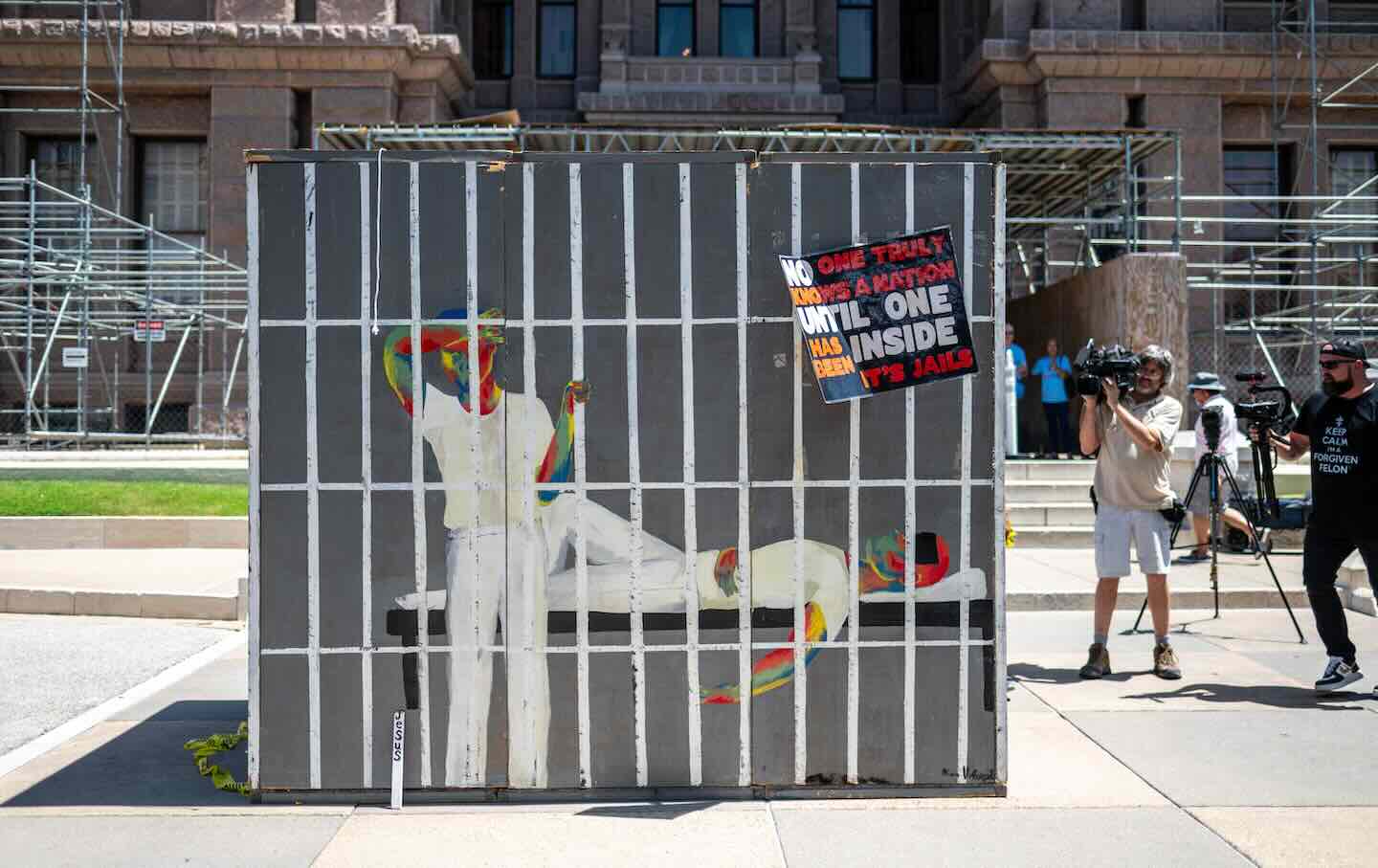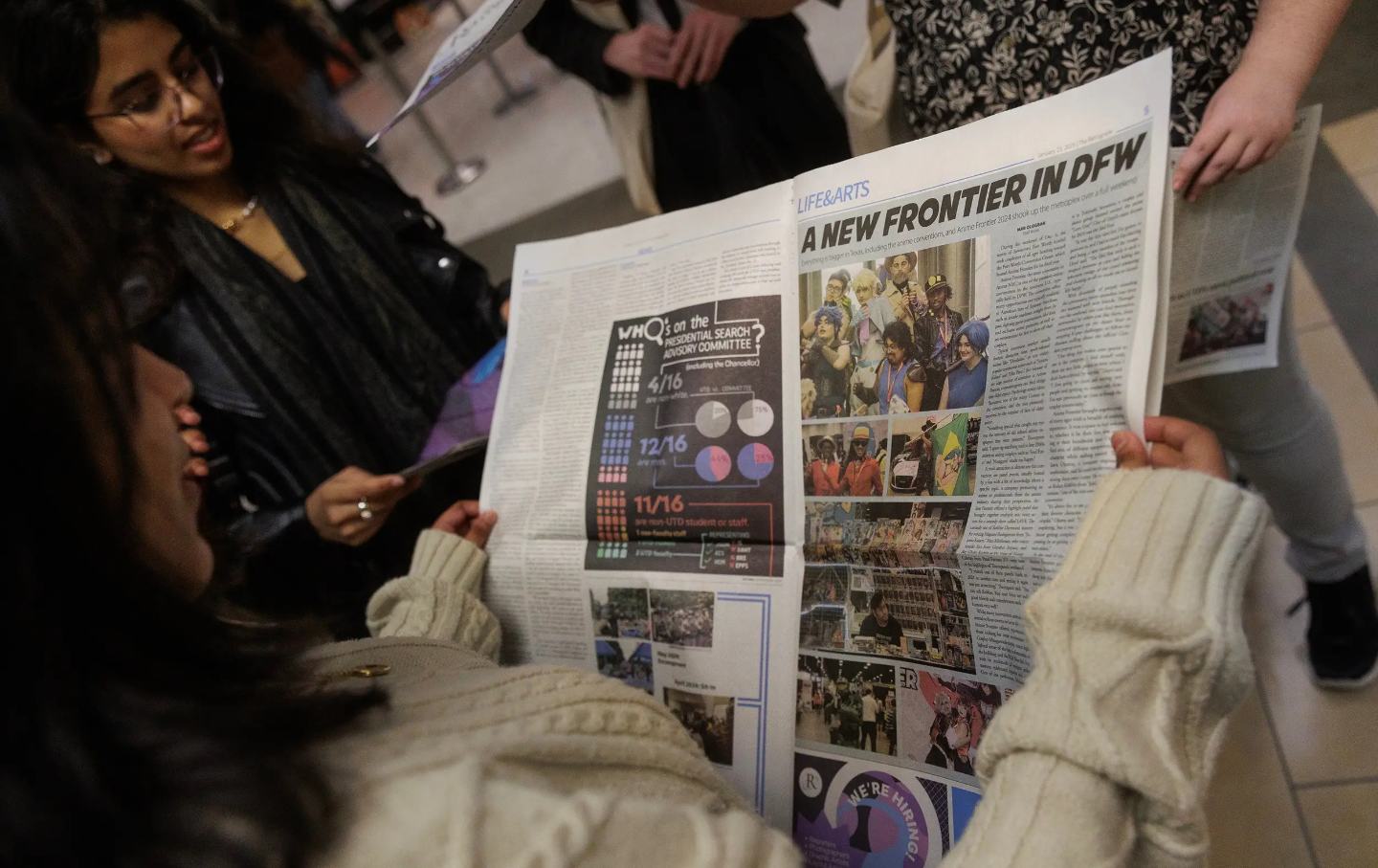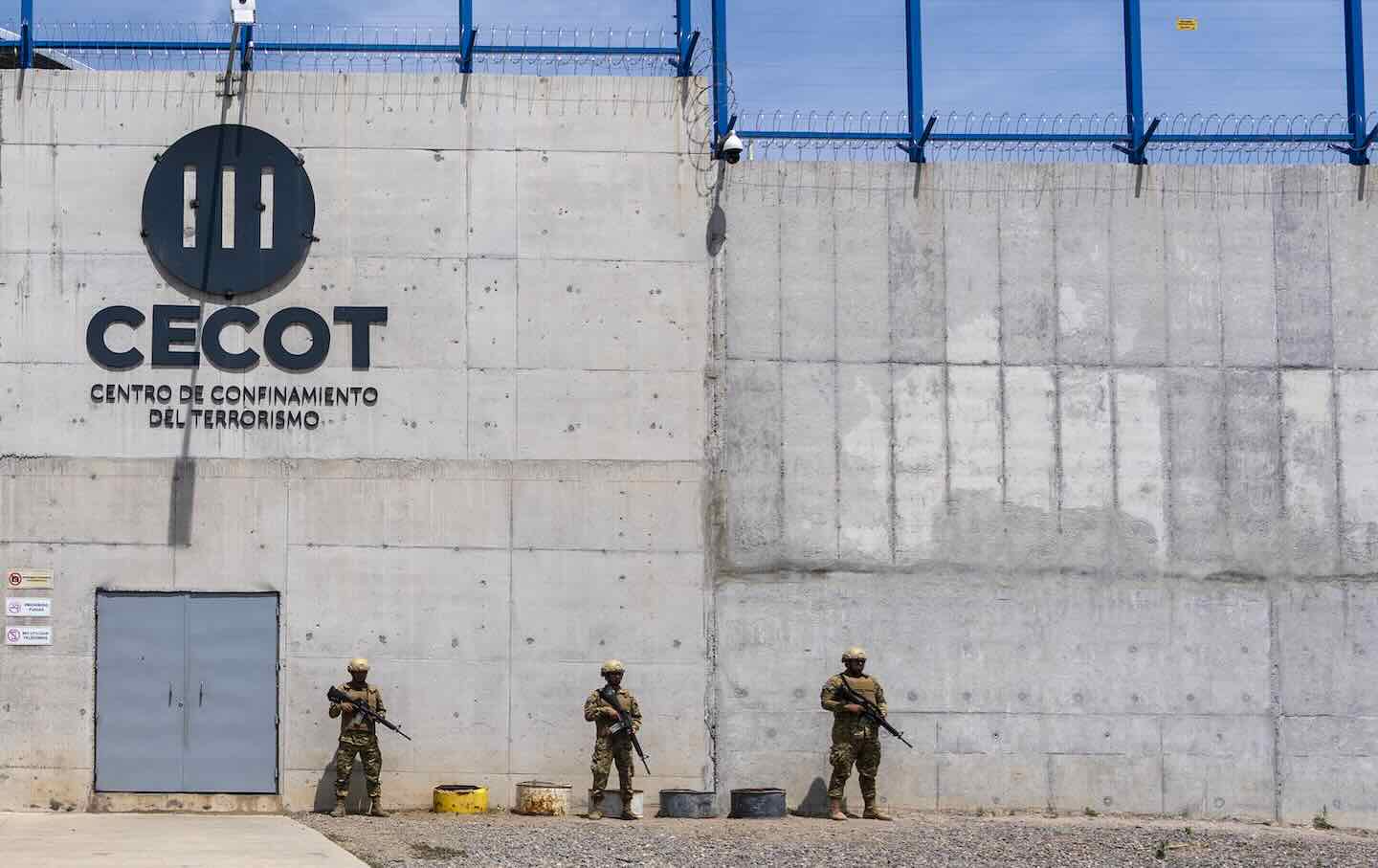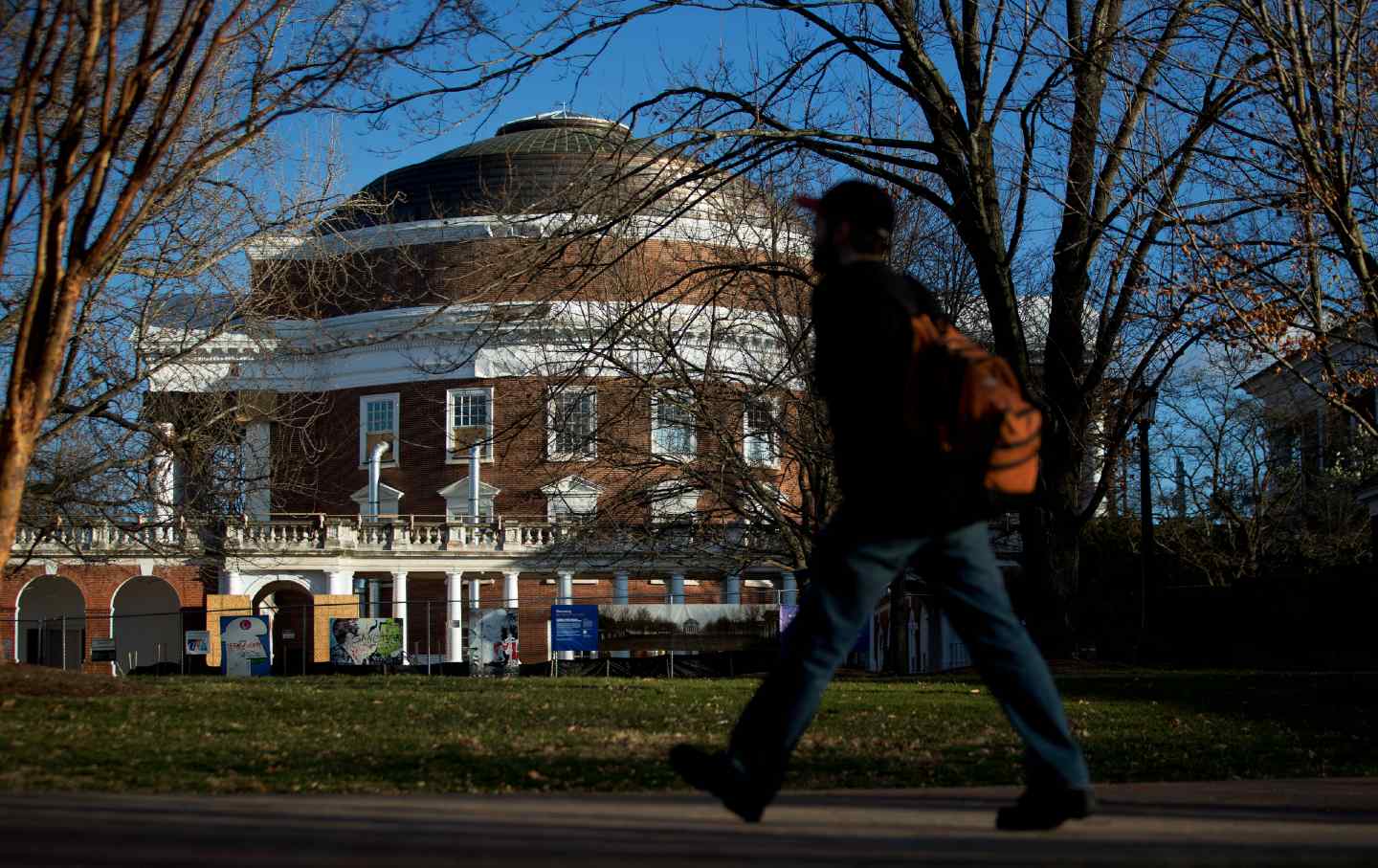Air Conditioners Can Only Do So Much for Those Behind Bars
Extreme heat has long been a concern for incarcerated pregnant women and those behind bars with underlying health conditions.

A mock prison cell, intended to simulate the heat inside prision cells in Texas, sits outside the Texas State Capitol in Austin on July 18, 2023. Activists visited the capitol to discuss the need for air-conditioning in Texas state prisons.
(Photo by Sergio Flores / AFP)Ceyma Bina was five months pregnant when she was sent to prison. Most Texas prisons lack universal air-conditioning, but the state sends pregnant people to the air-conditioned Carole Young medical prison.
In October 2006, Ceyma Bina gave birth via emergency cesarean. Two days later, she was forced to say goodbye to her newborn and returned to prison, where her C-section stitches were left in for two weeks—exceeding the recommendation of four-to-seven days. The delay caused an infection that required antibiotics and daily dressing changes, Bina told The Nation. Dr. Libby Wetterer, a family medicine physician and fellow with Physicians for Reproductive Health, explained that the constant sweating and moisture caused by extreme heat increases the risks of wound or fungal infection in those who have had cesareans or require vaginal stitching.
But the complications for postpartum women behind bars don’t end there. Following a C-section, doctors recommend that patients rest and not lift anything heavier than their newborn for the first six weeks. However, Texas prisons require nearly all of its state prisoners to work, and give little accommodation to those who have recently given birth.
The infection delayed Bina’s transfer to another prison by a few weeks. One month after birth, although she was still healing, officials transferred her to a prison where she was assigned to the brutally hot kitchen. Each day, Bina had to lift and scrub industrial-size pots, and bowls, some weighing as much as 20 pounds. What she remembers during those months was a constant feeling of soreness from the continual strain on her abdominal muscles.
Four years after Bina’s experience, in 2010, the United Nations adopted the Bangkok Rules, standards that countries should adopt in their treatment of criminalized women. The Bangkok Rules emphasize that when sentencing or deciding on pretrial measures for pregnant people or primary caregivers of children, countries should favor non-incarceration measures. The rules have yet to be widely adopted—or even widely considered in the United States, where women’s incarceration has ballooned by 585 percent since 1980. Currently, about 4 percent of women sentenced to prison are pregnant. After giving birth, they will be returned to prison cells and required to resume working, typically with no postpartum accommodations.
At the same time, extreme-heat days are growing in number and are associated with a 3.5 percent increase in deaths per year. Even when not deadly, extreme heat behind bars exacerbates already precarious conditions. For women, soaring temperatures and lack of mitigation threaten to further devastate maternal health and other underlying issues.
It doesn’t have to be this way, advocates and currently incarcerated people charge. In Texas, the state Commission on Jail Standards requires all jails to maintain temperatures between 65 and 85 degrees Fahrenheit in all occupied areas. No similar law exists for its 101 state prisons.
This past April, several advocacy groups signed on to a lawsuit petitioning the court to change that. In early August, prison director Bryan Collier acknowledged in court that the extreme heat contributed to three deaths last year and said that installing air-conditioning was a “key priority” but would need more money.
Included in the death toll was 37-year-old Elizabeth Haggerty, who died less than two weeks after being transferred to the Lane Murray Unit from one of the state’s handful of air-conditioned prisons. Haggerty, who had diabetes, asthma, and high blood pressure, told her mother-in-law that she could not keep food down and had lost 12 pounds. Two days later, guards found her dead in her un-air-conditioned cell. An autopsy later revealed that she died of severe hyponatremia, or abnormally low sodium levels, which can be caused by perpetual perspiration and extreme heat.
Fifty-eight-year-old Mona Nelson is also at Murray Unit. She has lupus, an autoimmune disease that can damage the joints, skin, kidneys, brain, heart, and lungs. Lupus is more common in women, and more common and severe among African American women like Nelson. Extreme temperatures can lead to joint flares (stiffness and swelling), chest pains, fever, fatigue, rashes, skin lesions, abnormal blood clotting, and increased risks of heart attacks and strokes. Patients with lupus are advised to stay in air-conditioned or well-cooled environments during the sweltering summer months. When she was in an air-conditioned unit, Nelson experienced one flare in 18 months.
At Murray, however, summer temperatures frequently rise above 90—and sometimes near triple digits. Each time the temperature swells, so do her joints. She spends the day racked with fatigue and, even when upright, feels as if a suffocating weight is pressing against her chest, making it painful to breathe. “Even the hairs on my head hurt,” she told The Nation on a 93-degree day. All Texas prisons have air-conditioned respite areas, but Nelson says that the one time she requested to go, officers subjected her to a demeaning strip search. She refuses to put herself through that ordeal again.
Heat isn’t her only enemy. Forty to 70 percent of people with lupus have photosensitivity. “Any type of UV radiation—whether through a window or direct exposure outside can cause joint flares, swelling, and stiffness,” Dr. Michelle Eisenberg of Houston Rheumatology Consultants told The Nation.
Furthermore, flares caused by ultraviolet rays might last months and can affect bone marrow, kidneys, and other organs, says Eisenberg. Flares can also cause ongoing fatigue, increased pain, and notable decreases in quality of life as well as the need for new medications.
During the summers, sunlight streams through her window and hits her bed—and Nelson, causing her exposed body parts to redden and itch, warning signs of an upcoming flare. To avoid exposure to the rising sun, Nelson often sleeps on the concrete floor between her and her cellmate’s beds.
Nelson has a medical pass that restricts her from working prison jobs that are in direct sunlight. But she must still walk outside, often in direct sunlight, from her housing unit to the cafeteria, medical unit, and program areas. “The sun doesn’t stop shining because I’m on line at commissary,” she said.
While air-conditioning could decrease the risks of flares caused by extreme heat, it would not change her daily exposure to direct sunlight nor change the prison policy prohibiting people from covering their windows against the scorching sunlight.
Days before Haggerty’s death, Nelson suffered a heat stroke. “I was throwing up and had stopped sweating altogether,” she told The Nation. When she was finally able to get to the clinic, medical staff put her on an IV to rehydrate her, a shot for the nausea, and antibiotics. Three hours later, they sent her back to her cell where her only respite came from the electric fans she had bought from the commissary for $22 each. But, cautioned Carolyn Sufrin, medical anthropologist and associate professor at John Hopkins University, when temperatures exceed 90 degrees, air circulated by electric fans is hot enough to actually raise the body’s core temperature.
Nelson agrees. “You ever see the fan blowing in the microwave?” she asked in comparison. “It’s just circulating hot air.”
At Perryville, Arizona’s sole women’s prison, some housing units have air-conditioning. But unlike Texas state prisons, pregnancy does not guarantee a climate-controlled bed.
Mandy Gloria was nearing the start of her third trimester when she entered Perryville in April 2008. She was placed in a unit with no air-conditioning. As her pregnancy progressed, temperatures soared to triple digits.
“It’s like living in a sauna,” she told The Nation. “The bricks heat up and hold the heat inside. When it’s humid, the air is so thick you can’t breathe.”
Extreme heat is incredibly dangerous at all stages of pregnancy, Carolyn Sufrin reminded The Nation. The high temperatures and resulting dehydration can lead to pre-term birth. It also increases the risks of low birth weight, preeclampsia, hypertensive disorders, and even stillbirth. Dehydration also lowers the threshold for heat stroke and heat exhaustion during pregnancy.
Popular
“swipe left below to view more authors”Swipe →“The more you’re exposed to extreme heat, the greater the risk of complications,” she said. “Even one day of being exposed to extreme heat exposes those risks.” These risks aren’t limited to the fetus—a 2023 study found that prolonged exposure to extreme heat can result in cardiac arrest, eclampsia, heart failure, sepsis and maternal mortality and that the risk increased 27 percent during the third trimester.
Gloria recalled that prison officials allowed pregnant, elderly, and women with medical complications to sleep in the air-conditioned visiting room. But to do so, each woman would have to push her mattress on a cart about a quarter mile in the heat every evening. “I chose not to go most nights because it was too much for me to move my whole bed and carry it to visitation at 8:30 in the evening and pack up at 4:30 am,” Gloria said. “It was almost better to stay in the room because sleeping in AC and then acclimating back to the heat all day made me sick.”
But that wasn’t her worst pregnancy experience. That August, Gloria started feeling contractions. Officers brought her to the medical unit, but she said that the nurse accused her of faking labor in order to eat better food at the hospital. She was returned to her cell where she gave birth to her son, alone. Women in surrounding cells banged on their doors until they caught the guard’s attention. The same nurse who had accused her of faking her labor arrived, cut the umbilical cord, and then called for an ambulance. Gloria spent two days at the hospital with her eight-pound newborn, then was returned to prison, to the same hot cell where she remained at risk for dehydration, heat exhaustion, and heat stroke.
Like many prison injustices, Gloria’s birth experience is not exceptional.
In 2020, at the Tarrant County Jail in Texas, which has air-conditioning, 21-year-old Chasity Congious gave birth in her cell after unsuccessfully trying to flag the guards’ attention. The baby was born with her umbilical cord wrapped around her neck and died 10 days later at the hospital. (The following month, prosecutors dropped charges against Congious, who was released from jail.)
Wetterer worries about the impact of climate change on those behind bars. But, she added that focusing solely on the effects of extreme heat might lead to building prisons with infrastructure for climate control rather than reexamining and reversing decades-long incarceration policies.
“I want to work on getting people out of prison,” she said. “I used to write letters for New York Lawyers for the Public Interest to get people out of Rikers for various reasons. I can imagine writing letters about extreme heat, menopause or pregnancy, any of these reasons. But it makes you think, Could there be federal or state legislation about limiting sentences when there are these conditions for all people?”








